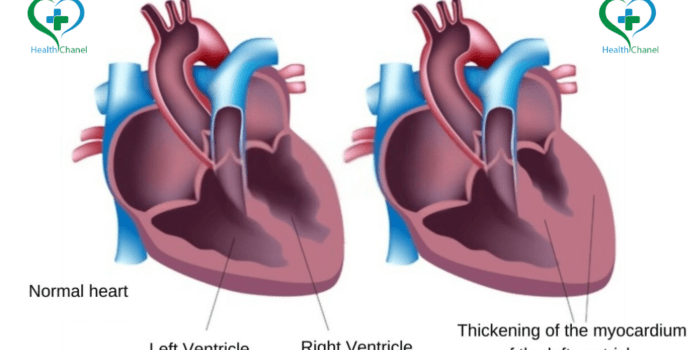Left ventricular hypertrophy (LVH) is a condition in which the muscular wall of the heart's…
Reason Why Women Don’t Get the Same Treatment for Heart Disease as Men?

Heart disease is the major cause of death in both women and men in the USA. However, women are more likely than men to be treated for heart disease. According to the American Heart Association, one in three women dies from heart disease, but many people still consider it a “man’s disease. This led to significant differences in the treatment and outcome of heart disease between men and women. So why do women not get the same treatment for heart disease as men? Let’s discuss this question.
Introduction
Heart disease refers to a variety of illnesses that affect the heart, including
- Coronary artery disease
- Heart failure
- Arrhythmias
Although heart disease affects both men and women, research shows that women are frequently diagnosed, go untreated, and suffer worse than men. There are many reasons, including differences:
- Symptoms
- Diagnostic tests
- Treatment options
Symptoms of Heart Disease in Women as Compare to Men
Women have heart disease differently than men. Although chest pain is the most common symptom for both men and women, women often experience other symptoms such as
- Shortness of breath
- Nausea
- Vomiting
- Back or jaw pain
- Fatigue
These symptoms can be subtle and easily missed, leading to delays in diagnosis and treatment.
Diagnostic Tests for Help to Treatment for Heart Disease
Although most diagnostic tests for heart disease are the same for men and women, there are differences in the nature of the disease and women may need additional tests. Women may experience various symptoms or medical conditions that may affect the results of some tests. Here are some of the common medical tests for heart disease in women:
Electrocardiogram (ECG or EKG)
A non-invasive test used to monitor the electrical activity of the heart is an electrocardiogram (EKG). This test can help identify abnormal heart rhythms, such as arrhythmias, which can increase the risk of heart disease. In women, an EKG can also be used to diagnose heart disease that presents with a typical symptom, such as shortness of breath, fatigue, or chest discomfort that is not typical for angina.
Stress Tests
Stress testing, often known as stress testing, is used to determine how well the heart responds to physical exertion. During stress testing, the patient exercises on a stationary treadmill or bike while heart rate, blood pressure, and EKG are monitored. This test can help diagnose coronary artery disease, which is a common form of heart disease that can cause chest pain or discomfort during physical activity.
Echocardiogram
Echocardiography is a non-invasive test that creates an image of the heart using sound waves. This test can help diagnose heart diseases, such as heart valve problems or abnormalities of the heart muscle, which can cause symptoms such as shortness of breath, chest pain, or fatigue.
Nuclear Stress Test
A nuclear stress test is a test that uses a small amount of radioactive material to help visualize blood flow to the heart. This test can help diagnose coronary artery disease, as well as evaluate the effectiveness of treatments for heart disease.
Cardiac Catheterization
Cardiac catheterization is an invasive test that involves inserting a thin tube, a catheter, into a blood vessel in the arm or leg and leading it to the heart. This test can help detect blockages in the coronary arteries and can measure pressure and blood flow in the heart. In women, cardiac catheterization may be used to diagnose heart disease that is not detected by other tests or to evaluate the effectiveness of therapies for heart disease.
Coronary Angiography
Coronary angiography uses X-rays and special dyes to examine the coronary arteries. The test can help identify blockages in the arteries that could cause heart disease and can guide treatment options, such as angioplasty or coronary artery surgery.

Treatment for Heart Disease
Although women are diagnosed with heart disease, they are less likely than men to receive Treatment for Heart Disease. This may be due to a variety of factors, including a lack of knowledge among healthcare providers about the differences in treatment options for men and women. For example, women may be less likely to accept recommended medications such as this
1: Aspirin
2: Beta-blockers
3: ACE inhibitors
Women are also less likely to have invasive procedures, such as angioplasty or bypass surgery, despite being indicated.
Factors Contributing to the Disparities in Treatment for Heart Disease
Several factors contribute to gender differences in the treatment for heart disease.
• Another factor is the underrepresentation of women in clinical trials for heart disease. This means that the effectiveness and safety of medicines in women may not be known.
• Social and cultural variables also play a role. For example, women may be less likely to seek medical attention for symptoms as a result of their role as a caregiver.
What Can Be Done to Address the Disparities?
To address the disparities in treatment for heart disease between men and women, several actions can be taken.
- First, there needs to be greater awareness among healthcare providers and the general public about the differences in symptoms, diagnostic tests, and Treatment for Heart Disease options for women.
- Additionally, there needs to be a greater emphasis on including women in clinical trials for heart disease.
- Finally, more research is needed to better understand the underlying causes of the disparities and to develop more effective treatments for women.

FAQs
• What are the risk factors for heart disease in women?
Risk factors for heart disease in women include high blood pressure, high cholesterol, smoking, diabetes, obesity, and a family history of heart disease.
• How is heart disease diagnosed in women?
Diagnostic tests for heart disease in women include electrocardiogram (ECG or EKG), stress test, echocardiogram, nuclear stress test, cardiac catheterization, and coronary angiography.
• Why are women less likely to be treated for heart disease?
Women may receive less aggressive treatment for heart disease due to a lack of knowledge by healthcare providers about the differences in treatment options for men and women, as well as social and cultural factors.
• What can women do to reduce their risk of heart disease?
Women can reduce their risk of heart disease by maintaining a healthy weight, exercising regularly, avoiding smoking, eating a healthy diet, managing stress, and seeing their doctor regularly.
• Can heart disease be prevented in women?
Heart disease can’t always be prevented, but any risk reduction measures can help reduce the risk of heart disease in women.
• What can be done to improve the treatment of heart disease in women?
Successful treatment for heart disease in women requires increased awareness among healthcare workers and the general public about the differences in women’s symptoms, diagnostic tests, and treatment options. In addition, more attention should be paid to women in clinical trials for heart disease.
Conclusion
Heart disease is a major problem for both men and women, but women are more likely to develop heart disease than men. This can happen for a variety of reasons, including different symptoms, diagnoses, and Treatments for Heart Disease. Discusses the differences between male and female heart disease and cardiovascular disease, and Treatment for Heart Disease for women. By taking these steps, we can work to make everyone, regardless of gender, receive the best possible care for heart disease.
Also, Read Other Articles
Responsibilities of Women’s Care Specialists: Ensuring Quality Healthcare for Women
10 Tips to weight loss at home for females?
Best Hair Loss Treatment for Female | Female Pattern Hair Loss
Signs of an Unhealthy Heart | Risk Factors for Heart Disease


